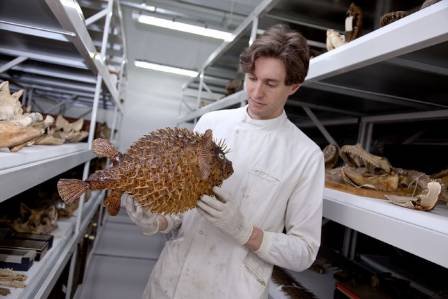After all that build up in my first post, the Scillionian boat trip wasn't that good and it wasn't that bad. So no sharks, whales, sunfish, etc but also no vomiting and I ended up spending most of the journey asleep.
The Scillonian after our arrival at St Mary's, Isles of Scilly
[I'm going to have to go off at a tangent slightly now and say that I've just this second been recognised by a small blonde lad as I sit here in the pub typing this. I will explain why in a bit.]
Anyway, we disembarked and trudged up and over a hill to the most western part of St Mary's which is called the Garrison or Woolpack. I've stayed in a few interesting places in my time but our current lodgings are the first that look like they could withstand a direct hit from a scud missile, being in an old military bunker. However, they are comfortable enough and we soon feel at home, although I can't help but feel sorry for the poor swallows who foolishly decided to raise their family in the corridor leading to the showers and toilets.
[I've just been recognised again, this 'fame' will start to go to my head if it carries on.]
Once we'd settled ourselves in, Mark Spencer, experienced botanist and exhibition leader took us for a walk around the island in the sunshine and points out all the parts of it that we can graze upon. Particularly nice are plants called three cornered leeks which have a spring onion/garlic taste.
The lighthouse at Peninnis Head.
The next day we rise early as one of my first obligations is to help with three talks for children (who seem to still remember me, hence the recognitions tonight as I write this) at the local Five Islands School. These go really well and Jon Ablett, Curator of Molluscs, steals the show with his squid dissection.
I don't have any props myself (apart from a baby pollock which is deemed unsuitable for hacking up in front of six-year olds, having proper red blood as opposed to the squid's green variety) so we find a few pictures of deep-sea anglerfish and sharks and I tell the children about those, and then attempt to identify various fishes that they tell me they've seen. I'm also getting a bit worried about the success - or potential lack of it - of my fish collecting at this point so I ask them to bring anything they can find up to our lodgings and give it to me.
My worries increase later as we spend a couple of hours fishing beside a sewer pipe with no results. Meanwhile everyone else is gathering buckets full of material - molluscs, plants - and diligently sitting around scribbling in notebooks and writing labels. Determined to get something - anything - of the fish variety, Jon, Tom Simpson and I head down to the beach at Hugh Town with our seine net, and after a lot of mucking about we finally catch our first, a baby sandeel. I hope things improve tomorrow...
Jon and Tom attempting to seine
My first fish, a sandeel



